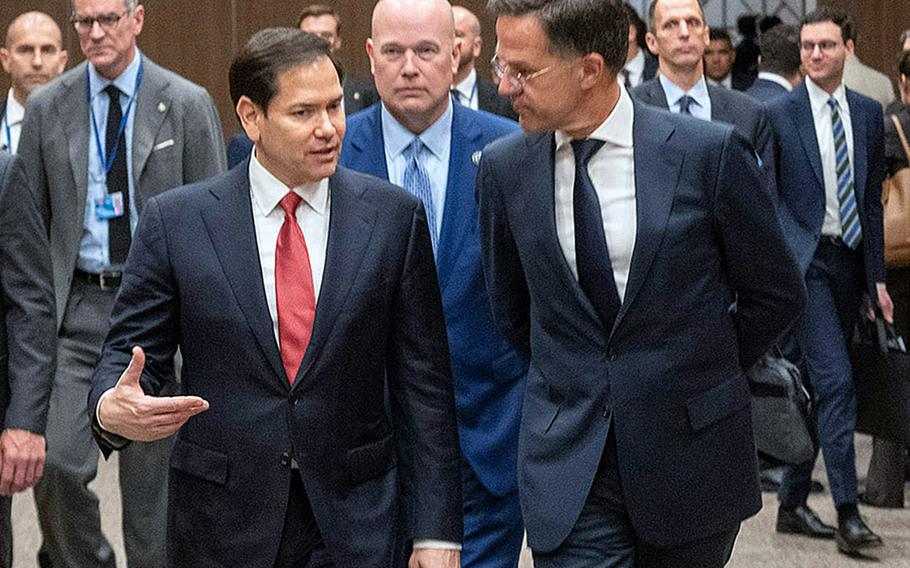
Secretary of State Marco Rubio talks with NATO Secretary-General Mark Rutte May 15, 2025, at a NATO foreign ministers meeting in Antalya, Turkey. (NATO)
U.S. Secretary of State Marco Rubio told NATO allies on Thursday that much more defense spending is needed to reinforce the 32-nation security pact.
Rubio, who is in Turkey for a foreign ministers meeting and high-level peace negotiations between Ukraine and Russia, said progress on a plan for more robust military investments is needed ahead of a NATO leaders summit in June.
“The alliance is only as strong as its weakest link, and we endeavor to have no weak links in this alliance,” Rubio said as NATO discussions began in Antalya.
The gathering of foreign ministers comes one month before President Donald Trump and other heads of state meet in The Hague, Netherlands, to discuss the future course of the alliance.
Defense spending is expected to be at the top of the agenda. Trump has demanded that allies increase their military investment levels from the current NATO minimum of 2% of gross domestic product to 5%.
Rubio said that Trump’s budget, which calls for $1 trillion in defense spending, is headed in that direction. He called that level of American defense expenditure “unheard-of” and “unparalleled.”
“And it’s not just spending money,” Rubio said. “It’s spending money on the capabilities that are needed for the threats of the 21st century.”
The White House’s focus on major increases means many allies that are already struggling to hit the 2% mark will be under significant pressure to do more.
Germany, which reached 2% in 2024 after years of criticism from Washington for not investing enough in defense, now said it’s prepared to move toward Trump’s 5% demand.
“We will follow him in this respect,” German Foreign Minister Johann Wadephul told reporters on the sidelines of the NATO meeting.
NATO Secretary General Mark Rutte said Thursday that eight of the alliance’s 32 members still fall short of the 2% benchmark.
“We need to do much, much more, and that’s exactly what we will focus on today,” Rutte said. “There’s also a clear demand from our biggest ally to make sure that we equalize in terms of spending with what the U.S. is doing and what Europeans and Canada are doing.”
In NATO, there has been significant progress toward the 2% mark over the past decade. The increased threat posed by Russia and pressure from Washington have been driving factors in those increases, NATO officials have said.
However, it’s not clear how many members are prepared to meet Trump’s new spending demand. Also uncertain is what the consequences will be for NATO if members push back on Trump’s spending benchmark.
Over the years, Trump has said the U.S. commitment to NATO and the defense of allies are linked to member states’ fulfillment of their spending obligations.
While some countries, such as Poland, already have plans to get to the 5% level, others are barely at 2%. One plan being circulated calls for 3.5% of GDP spent on defense and an additional 1.5% related to military infrastructure.
Rutte declined to confirm the formula, saying that negotiations are still going on and that a debate on the details will be held at the meeting in Turkey.
Rubio said dramatic increases in defense spending are needed for NATO to carry out its core mission.
“The purpose of NATO is to prevent wars through its strength, and that’s why we want to see it grow stronger,” Rubio said. “Spending levels among all partners that allow everyone to be stronger make the alliance stronger.”